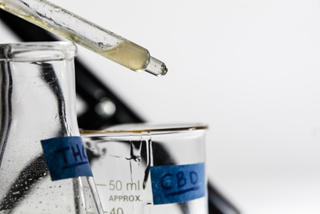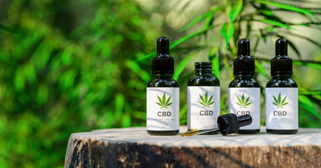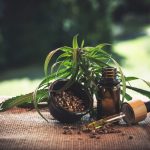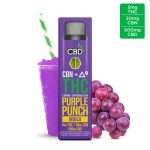This is a sponsored guest post.

Cannabidiol, or CBD, is a compound unique to cannabis that seems to help the body repair itself. Though more research is warranted to
fully understand CBD’s effects, for now researchers believe that the compound triggers the body’s endocannabinoid system to produce
more neurotransmitters to address issues like muscle tension, pain, stress and the like. As a result, CBD products are like bottled calm; they
help the body relax and heal without the danger of overdose or negative side effects.
However, there is usually more than just CBD in your CBD products. In fact, the very ingredient that most people expect to avoid is often lurking just below the surface: THC.
Like CBD, tetrahydrocannabinol (THC) is a cannabinoid that engages the endocannabinoid system, causing various effects like muscle relaxation and stress relief. However, THC also has effects on the brain, causing various types of mental and physical impairment, and it is possible to overdose on THC — though not in a life-threatening way. Still, most CBD users do not want THC in their products, so why is THC still there, and how can you go about avoiding it?
Why THC Is in CBD Products
CBD products undergo processing to remove unwanted compounds, like the plant fiber, plant fats, terpenes and, indeed, other cannabinoids. However, there are a two good reasons CBD manufacturers opt to keep some compounds, notably THC, in their final CBD products:
1. THC is difficult to remove.
THC is the most abundant cannabinoid within modern varieties of cannabis because most cannabis growers around the world have focused generations of work on increasing THC content to intensify the marijuana high. Extracting only CBD from these weed strains is almost impossible without severely limiting the amount of CBD in the final product. Manufacturers typically prefer to leave in some THC than risk the elimination of all CBD. Plus, such intensive extraction and refinement is already expensive and time-consuming, and manufacturers don’t want to impact their bottom line unnecessarily.
Fortunately, as CBD has gained popularity, more growers are focusing on producing cannabis crops with high CBD and low THC. In fact, the 2018 Farm Bill permits the cultivation of cannabis with a THC content lower than .3 percent, which is to be used for the production of CBD products or else for its fiber or seed. Currently, American farmers aren’t familiar enough with cannabis to reliably raise high-CBD, low-THC plants, but the near future might bring advancements in hemp agriculture and purer CBD products.
2. THC might be beneficial.
THC’s dominant effects are psychoactive, which is why many CBD users want to eliminate THC from their products. However, THC might have other, less noticeable effects that provide benefits like CBD —and it might impact how CBD functions, as well. There is plenty of anecdotal evidence that various compounds within cannabis work together to provide an “entourage effect,” boosting positive effects and mitigating negative effects for users. Many users believe that CBD helps the body metabolize THC faster, making it much more difficult to overdose; likewise, THC might heighten CBD’s healing effects.
There is little scientific evidence for the entourage effect — but that could be a symptom of the general lack of research on cannabis in general. Many cannabis users believe that the entourage effect exists, so manufacturers tend to leave natural compounds within their CBD products to cater to consumers looking for them.

How to Identify CBD Products With THC
Comparisons of CBD vs. THC are useful to help guide you to the products that you most benefit from. Yet, you also need to know what to look for when shopping for CBD products, considering that the world of CBD has a lexicon that might be unfamiliar. Here are some important terms that describe a CBD product’s THC content:
- Full spectrum. Full-spectrum CBD contains all compounds naturally found in cannabis, from terpenes and essential oils to trace cannabinoids and THC. Typically, THC is extremely limited and thus non-psychoactive, but if you see “full spectrum” on your CBD product, you should look into its THC content.
- Broad spectrum. In contrast to full-spectrum products, broad-spectrum CBD contains all
compounds except THC. This is supposed to provide the benefits of the entourage effect
without the downsides of THC. - CBD hemp. Hemp is legally defined as cannabis with THC content lower than .3 percent, so any
product labelled with the term “hemp” likely has some THC, but only minute amounts. - Raw CBD or CBD isolate. Both raw CBD and CBD isolate are products that contain only CBD and
no other compound from cannabis. However, it is worth noting that you will likely pay a
premium to use these products considering the effort required to manufacture them.
Whether you enjoy having small amounts of THC in your CBD products or you want to eliminate THC entirely from the products you use, you have the power to control your THC intake — if you know how to spot the signs of THC in your CBD.

Hi there! I am Emily Evert, the owner of Emily Reviews. I am 28 and live in a small town in Michigan with my boyfriend Ryan and our two pugs. I have a large family and I adore my nieces and nephews. I love reading memoirs, and learning about child development and psychology. I love watching The Game of Thrones, Teen Mom, Sister Wives and Veep. I like listening to Jason Isbell, John Prine, and other alt-country or Americana music. I created Emily Reviews as a creative outlet to share my life and the products that I love with others.
This post currently has no responses.








Leave a Reply